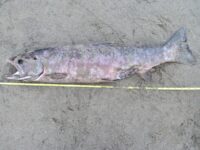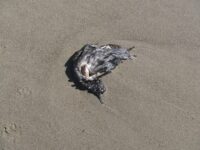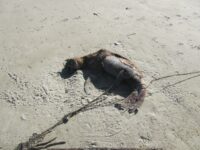Mile 94 Report
West of Laurel Lake, Lost Lake
October 18, 2011
Beach sand and wet sand very clean.
Report Details
Beach sand and wet sand very clean. One nine by twelve by three foot concrete dock or pier on dry sand. Flock of over a hundred gulls of two species together on wet sand. Flock of about thirty Sanderlings (?) on wet sand. Elk prints on West bank of New River. ATV tracks on west bank of New River. More types of denser and taller vegetation on both banks. As usual, no people.
Conditions
Temperature: 70 F. Cloud Cover: Sunny. Wind Velocity: Calm/Light. Tide Level: 4.0 feet.
Human Activities
Number of people: 2. Number of dogs: 1. Walking or running: 3. Beach Walk Tuesday, October 18th, 2011Mile 94Blaine sent me out by myself, saying she would meet me at the bottom of the BLM path. So, Lucie and I shouldered the oars and walked along our mown path down to our dinghy, the Second Sea Sprite, for our first bye-bye-in-the-boat on this visit to our Lonely Plover beach house.The weather was absolutely perfect. Still, sunny and almost hot. I shed my sweat shirt and tee shirt and flip flops when we reached the boat. We got in and pushed off and rowed down Lower Fourmile Creek. There was more vegetation growing in the creek than I have seen previously.When we rounded the corner onto the New River, heading north toward where I thought might be a good spot to beach the craft to pick up Blaine, who was going to walk down the BLM path and meet us. I noticed that the vegetation on the east bank had grown taller, and I could no longer see the lower windows of our upper floor from the dinghy. Either the water level was lower or the vegetation was taller. It proved to be the latter when I later found I could no longer see the big log on the East bank from our house.Lucie and I enjoyed the still warm air and watched little fish flash their silver sides as they jumped out of the water. They were, I think, between two and three inches long. I wonder if a larger predator was after them beneath the surface of the water. The water in the river was clearer than I can recall, but the angle was low so I couldn’t see anything beneath the surface from where they propelled themselves into little arcs thru that thin fluid, air.Eventually, Blaine arrived to enjoy one of the rare perfect days for a beach walk along Mile 94. I rowed us across and found that the vegetation on the west bank of the New River was more intense, thicker and varied than in the past. There were willows, dandelions and strawberries, none of which I recall seeing over there before. At least this time I didn’t see any gorse. But I did find raccoon tracks at the edge of the water.We made our way over the dunes and down onto the beach. The beach was not nearly as wide as it had been on mile 95, further north. The waves were very small, most less than two feet trough to crest with the tallest being only about three feet. The ocean was flat and grey-green as we set out. It became somewhat more blue as our morning passed.We crossed the dry sand and headed north. There was a mist along the ocean, so we could not see the haystacks in front of Bandon to the north nor Cape Blanco to the south. Puzzling since the waves were small so to not generate much spindrift, and the air was clear over on the meadow. It was only on our return, an hour or so later, that we could make out the outline of the shoulder of Cape Blanco against the sky.Early on we saw two flocks of birds. One numbered around thirty and were probably Sanderlings on the wet sand. They took flight as we approached. Shortly beyond them, also on the wet sand, was a much more numerous flock of two types of gulls. I estimate they were more than one hundred. One type was larger and exhibited quite a bit of white, the other smaller variety, showed more brown. But they were milling about together, and we wondered what food source might have attracted so many, if that was what it was. We walked to where they had been but couldn’t determine the attractant.The beach itself was very clean. We saw only one clump of bull kelp, about thirty feet long, on or near the wet sand, during our first fifteen minutes. No crab parts, no shells or jellies, no other seaweed, no little pieces of wood, no feathers, nothing, save for the little rocks that were smaller than golf balls here and there on the sand, perhaps a few per square yard. Interestingly, the sand was fine without any coarseness,just sand and little water-rounded pepples. Blaine collected a few white ones.Along the way, as we were on the west bank of the New River (which I call Far Rock-away) we found cloven hoof prints too big to be deer. We assumed they were elk, although not as large as the long trail of tracks we had found on an earlier visit. Later Dr. John Merle Logan, our neighbor and Professor Emeritus from the University of Texas A&M, told Blaine at a Bandon Community Health Center Board meeting, he had seen two elk on the far bank of our river earlier that morning.The most amazing thing along our way was the discovery of a huge piece of a dock sitting in the dry sand. It measured about twelve feet by nine feet and three feet thick. All were apparently two solid pieces of concrete. There were wood timbers attached on the two long sides with some nuts still shiny, they must have been stainless steel. There was a rusted metal box, perhaps two feet by two or three by three, attached to one end with a big steel pad eye and a metal hitch hanging from that, two pastic rollers and two big cleats, suitable for mooring a pretty substantial boat on top. We could not imagine how such a thing could be up on the beach. What force could have conveyed it here?Later, in a conversation along our lane with neighbors Christine and Hanspeter Witschi, who also monitor this portion of the wild and desolate Oregon coast, we learned that those massive pieces of concrete are actually hollow and the whole thing can float,and they had found it before, further North, while they were with the Bilderbacks on another beach walk of their own.As we passed the points where the waves had first overtopped the dunes, we crossed over the sand to the West bank of the New River. As we made our way further north, we found a beautiful piece of white driftwood, the remains of a big tree’s root system and bottom of its truck. It was taller than me, and we dubbed it the Mermaid’s Throne, an echo of the Mermaid’s Chair, a similar piece that used to occupy a spot just across from where the Sandy Path across what is now Bandon Biota land comes to the east bank of the river. I am looking forward to coming back with a camera. We also found some ATV tracks on the sand of the West bank and wondered if they were authorized government tracks or unauthorized poachers. On another visit, that time along the Sandy Path, I found evidence that the ATV had come in from the north. In addition, there were also footprints left by people in that area. Normally Blaine and Lucie and I do not find any tracks on Far Rock-away.We saw three small birds, Sanderlings?, on the sand and in the shallow still water of the New River. One was engaging in an unusual hopping pattern, and we realized it had just one leg. When the three of them took flight that one flew well, the same as its companions.As we returned to the dry sand on the west side of the dunes we found several places, each covering several square yards, with intense concentrations of bird tracks. The tracks themselves could have been covered with a dime. Not sure what made those spots so attractive to so many.Eventually, we made our way back to the dinghy and found that there definitely is much more vegetation in the mouth of the Fourmile Creek than in the past. It is some sort of long, thick-bladed grass growing up from the bottom of the water.The weather was still warm and still and sunny.
Concerns
Disturbances: Shorebirds moving in response to humans/dogs
Notable Wildlife
Flock of 30 plus Sanderlings (?) and over 100 gulls, some larger and white and some smaller and more brown.
Dead Fish or Invertebrates
Very little to none.
Driftline Content
Shells, Small rocks. Very few mussel shells, one or two oyster shells.
Man-made Modifications
Large part of concrete dock or pier.
Natural Changes
Evidence of wave overtopping.
Actions & Comments
Blaine brought back one small brown bottle.
All Mile 94 Reports
Mile 94
West of Laurel Lake, Lost Lake
Accessed mile by rowing down Fourmile Creek and beaching on west side of New River.
John Hull
Mile 94
West of Laurel Lake, Lost Lake
Dead lamb and salmon on the beach.
Volunteer Trainer
Mile 94
West of Laurel Lake, Lost Lake
More people than we have ever seen on a beach walk before, two fishermen in small powered boat on new River, one fisherman walking, and what appeared to be a family of three walking South along the West Bank of the New River.
John Hull
Mile 94
West of Laurel Lake, Lost Lake
Warm day, beach wide and fairly flat, pretty clean with occasional kelp, few jellies, dozens of crab carapaces, a few broken Sand Dollars, feathers, and some other crab parts.
John Hull
Mile 94
West of Laurel Lake, Lost Lake
Saw pelican with injured wing walking on beach and a dead baby sealion and three dead birds (just partial carcasses).
John Hull
Mile 94
West of Laurel Lake, Lost Lake
Once again no people nor signs of people.
John Hull
Mile 94
West of Laurel Lake, Lost Lake
Beach sand and wet sand very clean.
John Hull




